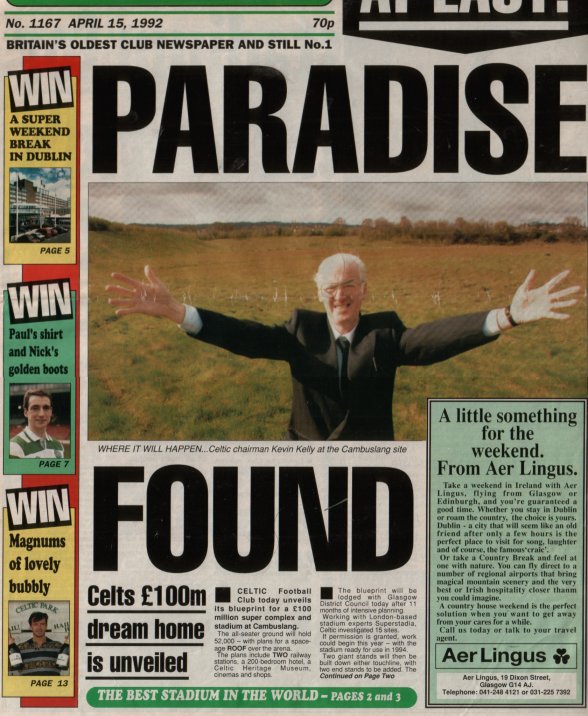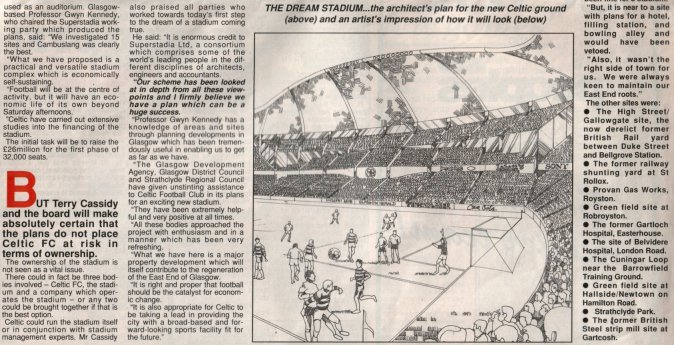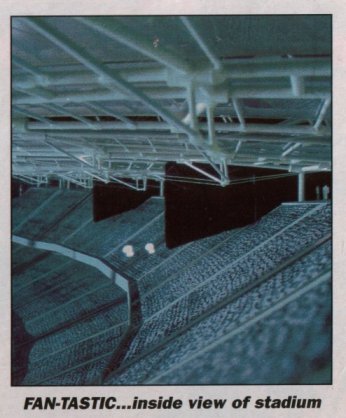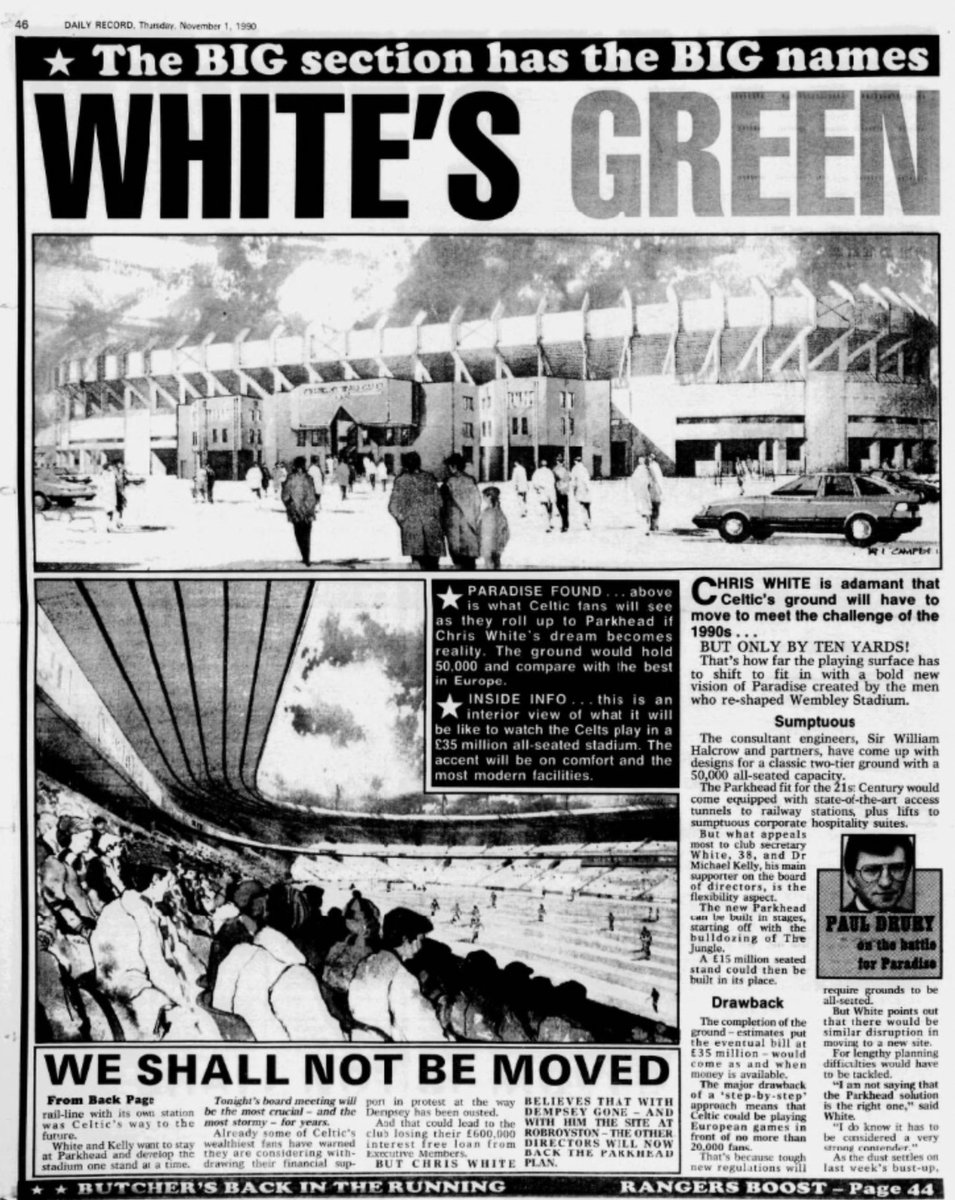Celtic Takeover | Celtic Park | About Celtic | Lennoxtown
Details
Ref: Cambuslang Stadium Plans
Notes: Proposed new stadium plans by old board to meet all seater stadium requirements.
Dates: 1992-1994
Cambuslang, Kevin Kelly and Space-age Roofs
In the 15th April 1992 edition (number 1167) of the ‘Celtic View’ the old board of Celtic announced bold plans for a brand new stadium to comply with the Taylor Report, which by then was less than two and a half years away.
The ‘Celtic View’ newspaper ran with various hyperbolic headlines like ‘Paradise Found’ and (the incredibly patronising) ‘World’s Best Stadium for the world’s best fans’ – it all sounded too good to be true, but no, here it was – Celts’ £100m dream home.
Our spiritual home at Parkhead was to be no more, we were moving to the new found land – Cambuslang.
The plans revealed in April 1992 included:
- A 52,000 all seater stadium
- Two Park & Ride rail stations from Glasgow city centre
- A retail village including major stores and car showrooms
- Parking for 4500 vehicles
- A Celtic Heritage museum
- Integrated Sports and Leisure facilities
- A permanent performance stage
- Mobile acoustic curtain enclosing up to 15,000 seats
- An eight-screen cinema complex
- A 30-lane ten-pin bowling alley
- Drive-through fast food restaurants
- Petrol station
- Office units
- Room for further expansion
Total cost, we were informed, was £100m and initially 32,000 seats (the two touchline stands) would be built with the rest to be added later.
Chairman Kelly said “For far too long, the Celtic board has faced a non-stop barrage of ill-considered criticism from uninformed people of dubious motivation“. Quite an impressive array of adjectives, I’m sure you’ll agree. Indeed, “ill-considered”, “uninformed” and “dubious” could rightly be used to describe the antics of Kevin and his merry band of acolytes.
He went on: “Our goal has always been simple – giving the very best to the most faithful fans in the world. We promised that they would be told of our plans first and we are now delivering on that promise. There will be further announcements as the plan develops in stages, with planning permission and funding of the scheme the main areas in which we have to progress“.
That last sentence summed it all up. Whilst these plans could be viewed as exciting, that’s all they were – plans. Kevin and his cohorts weren’t “delivering” on anything other than blowing some more hot air. No details of how such a project was to be funded had even being addressed never mind finalised. Kelly was happy to have a little snipe back at his critics (and there were many) but he seemed content to jump the gun somewhat. Accompanying this spectacular prose were some rough (and it has to be said, rather poor quality) drawings of what the arena would look like.
“They thought it was but it never was a realistic prospect. At the end of the day they never had any money and the club would have ended up as a tenant of some anonymous City investors. It’s the sort of desperate thing you dream up when you’ve nowhere to go.”
Celtic ‘Rebel’ Advisor David Low on Cambuslang stadium proposals
The four images, below, show that weeks’ ‘exciting’ news.


Green for Go, 2000 jobs and £78m
Details on Cambuslang in the ‘Celtic View’ cooled somewhat (i.e. were non-existent) until, that is, the 18 November 1992 edition (number 1196) where we were confidently informed on the front page that is was ‘Green For Go.’ Reports of the site chosen being a “toxic timebomb” were rubbished and a four page spread inside that weeks ‘View’ outlined the potential economic benefits to the local area. Kevin Kelly was pictured on the front page with two other blokes – Muir Morrison (“a leading surveyor with Ernst & Young”) and Gwyn Kennedy of development consultants Superstadia. Hmmm… Sharp-eyed pedants will note that the computer-generated image of the stadium had by now been rotated around 180 degrees – without explaination. On a more positive note the front page also informed us that Mike Galloway was out injured for a month, so at least there was some genuine good news… Another concern was the 14.3% increase in the price of the ‘Celtic View’ in a little over 6 months!
The four page spread inside contained, once again, little in the way of detail. The two centre pages of the spread was entirely devoted to clearing up any doubts about the toxic nature of the site, old mineworkings etc. “Goetechnic studies” had been carried out, apparently, and no major problems had been encountered. The report finished by stating that there was a risk of flooding from the adjacent River Clyde, but this was only likely “once every 100 years.” 100-1, eh? The same chance of the stadium being built at all, said the critics.
The first page of the spread focused on the economic benefits to Cambuslang itself. “2000 jobs and £78m – what the new stadium will give Glasgow.” Hang on – Cambuslang’s outside Glasgow, innit?? Anyway, it outlines the various benefits etc and informs us that Celtic had agreed a deal with the GDA (Glasgow Development Agency) to buy the Cambuslang land for £2m. Kevin Kelly, it says, shook hands on this “agreement” with Peter Reilly of the GDA. There’s even a picture of Kevin and Peter sitting at a table holding a piece of paper together. Luckily, that money only had to be paid when planning permission had been granted. Phew…
Another piece on the front page is interesting – “Cash is on the table.” This sounds promising – some details perhaps? Eh, not really, no. “Big money backers are waiting in the wings to turn Celtic’s stadium dream into reality. But they will remain in the background until a decision is taken on the council planning application.” Handy that, eh?… David Smith, “Depute Chairman” has a soundbite or two (none of which is worth my time typing out) and Patrick Nally of Superstadia “echoes Mr Smith’s words.” Maybe they were in a big cave together or something?
The fourth page of the spread contains a few other articles, including a picture of what the fabled ground will look like inside (shown below). The main piece on this page is titled “Best Brains in the Business – Captains of industry back stadium switch.” I swear I’m not making this up… However, upon closer inspection it becomes patently clear that this article is essentially nothing more than Patrick Nally’s (yes, him again) CV. Another blurb on the same page is simply a regurgitation of the April ’92 article that says “Celts looked at 15 sites” – 14 of which Celtic didn’t even own and, arrogantly, one of which was Hampden Park – as can be spotted above in one of the pictures of the aforementioned April ’92 edition “Celts took a look at Hampden as well.” Surely the obvious question should’ve been “why?!?”
At the bottom of the page, the final little bit is headlined “Costs in black & white.” It says the ground will be built in phases – phase one is the two touchline stands costing £26m giving 32,000 seats. Phase two is completing the circle (£4m more) meaning the lower tiers of the stands behind the goals – with no roofs. Phase 3 is completing the upper tiers – another £15m apparently. Costs? Yes. How are you gonnae pay for it? No.
The Taylor Report was to be implemented in August 1994 – now less than two years away.

Cambuslang – The End
On the Friday 25 February 1994, in the face of almost intolerable pressure, the board called a press conference – this was to be a quite dramatic announcement. Cambuslang was a reality. Chairman Kevin Kelly, Depute Chairman David Smith and Patrick Nally of Superstadia faced the media to deliver one of the most astonishing addresses ever given to the Scottish football press. In a pronouncement to match the ‘unsinkable’ tag applied to the RMS Titanic, Smith told an incredulous press pack that the funding for Cambuslang was in place thanks to a London-based company called Gefinor. Curiously, the capacity of the new ground was now just 40,000 – a whole 12,000 down on the plans revealed previously. No-one in the assembled media scrum even seemed to notice this little discrepancy, which probably says more about them, to be honest. There was to be a share issue which would finally allow the fans to buy shares. The board, we were being led to believe, had come through against all the odds and these plans for our Brave New Celtic World would be ratified at an EGM.
Smith’s posture during all this was something to behold – sitting with his arms folded as tight as they could get, his delivery was determined to the point of contemptuous. Patrick Nally was his usual bombastic self and Kevin Kelly, meanwhile, sat with the best ‘I’m a very powerful business man, you know’ look that he could muster.
The Evening Times vendor sellers boards around Glasgow city centre had ‘Celtic Stadium News’ boldly displayed on them that late afternoon – this was pre-internet days, of course – however, everyone knew it was a complete fairy story. Worse yet, it took about an hour to prove it. Gefinor were contacted. They denied any knowledge of finding money to give to the Celtic board. Superstadia, the company who were to design the new stadium, knew nothing about it, although they were adamant that they would be building it. Their high powered, moving and shaking offices looked like some kind of dodgy taxi rank. The whole plan was ridiculed on that nights evening news programmes, with anti-Celtic media muppets like Gerry McNee wallowing in their pathetic element. It was to be the last misjudgement of the Kelly/White/Grant regime.
The following Tuesday Gefinor officially stated that they had nothing to do with the Celtic plans. They had held talks with Stadivarious, but nothing was agreed, or signed. An executive for the bank said that they were “shocked by the announcement of a deal.” It was all going seriously wrong for the board now. Wednesday March 2nd was one of the strangest days Celtic Park has ever seen. The Celts for Change pressure group had declared an official boycott of the game. They were pretty confident that fewer than 10,000 people would attend. The board disagreed. Celts for Change stationed someone at every turnstile; they would compile their own attendance figure. When released the figures would differ by 2,000. But by then attendance figures were the last thing on the mind of the board members. The Bank of Scotland had received a request for payment from Sheffield United for the money they were owed for Willie Falconer.
The bank refused.
They contacted Celtic demanding an immediate meeting with the board regarding the level of debt at the club. In attendance were Kevin Kelly, Tom Grant, James Farrell and Jack McGinn. The Bank put the club’s financial position to the assembled directors – they sat in stunned silence. What the bank was telling them bore little resemblance to what they had been told by David Smith. Basically, the bank was ready to call in the receivers. Michael Kelly later said he thought this was a bluff by the bank! Immediately after the meeting the bank released a statement saying that the club was in “immediate and dire peril of being put into receivership.” An indication of how badly the club had been managed was the value of Celtic’s net assets – one sixtieth of Rangers’ value. Even Partick Thistle were valued at four times Celtic’s worth. Kevin Kelly called for the resignations of David Smith and Chris White on the basis that they had misled the board regarding the financial situation. He announced that the club had entered negotiations with Brian Dempsey and Fergus McCann over the future of the club.
A TV crew found David Smith at Glasgow airport; he was on his way to Celtic Park, and still trying to talk his way out of it. Things had been fine, he maintained, until the first 10 minutes of the New Year Old Firm game (a 4-2 doing at home, 3-0 down after 28 minutes) and the cup defeat by Motherwell (a 1-0 Fir Park humbling). Smith and Chris White quickly departed, selling their shares to McCann for a tidy sum, and Michael Kelly seethed off into the distance. Having sold his shares as well he was under the impression his cousin Kevin would sell too, and was deeply unhappy at Kevins decision to stay. Mind you, we were all a bit gutted that Kevin was still there…
Michael Kelly would later describe the removal of the old board as “the dirty campaign, conceived in vengeance, born in deceit.” That may well have been the case, but the fact was that the family dynasty that had controlled the club for nearly a century had constituted nothing more than a gravy-train for those lucky enough to be part of it. The members of those families considered the money that people like you and I paid to see Celtic to be their money. Anyone who dared try and ask for more was cast out, branded as greedy, unworthy of the Celtic jersey. And the worst part of it was that for too many years than we’d like to mention we all believed it. They fed us a mountain of garbage about the honour of wearing the jersey being worth more than money, and it was swallowed whole. Players like Dalglish and Nicholas were pilloried because they knew their worth and weren’t prepared to let themselves be short changed so that the directors could eat in the best places, and live in best houses on the strength of the talent of others.
By the end of Friday the 4th of March Celtic had a new team at the helm. The car park in Kerrydale Street was filled with jubilant fans, one of them yelling at the top of his voice the newspaper headline for the day – McCann’s the Man! The Bunnet had done it. Fergus McCann was the CEO, Dominic Keane was a director, Michael MacDonald (stepson of Gerald Weisfeld) was also now a director. Curiously, the man who had been at the forefront of the whole ‘rebel’ thing, Brian Dempsey, was not. He claimed to have no interest in returning to the Celtic Board, although he would be investing a substantial sum in the club. However, this money never appeared, and Dempsey’s relationship with McCann quickly soured. There are many rumours why this happened, most of them libellous. Suffice to say that The Bunnet decided not to move the club from Parkhead to Cambuslang (or anywhere else), and Brian Dempsey’s land in the Robroyston area remained undeveloped. Fergus already had his own plans for the stadium.
















